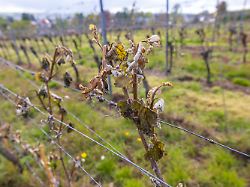Decrease of ten percent
Extreme weather causes historically poor wine harvests
April 25, 2024, 11:40 p.m
Listen to article
This audio version was artificially generated. More info | Send feedback
Droughts, fires and other climate-related problems are causing a significant decline in wine production. Although Germany is still getting off relatively well, the situation in other countries is much more dramatic, especially in the wine country of Italy.
Global wine production fell by ten percent last year. “Extreme environmental conditions” such as droughts, fires and other climate-related problems are largely responsible for the largest decline in the last six decades, said the International Organization of Vine and Wine (OIV). Accordingly, it was the world’s worst wine harvest since 1961 and even worse than initial estimates in November had suggested.
The worst affected were Italy and Australia, where production fell by 23 and 26 percent respectively. Spain lost more than five percent of its production, Chile and South Africa more than ten percent. In France, wine production bucked the trend and grew by four percent. Due to the large drop in production in Italy, France was by far the world’s largest wine producer last year.
In Germany, wine production fell by 3.8 percent from 8.9 million hectoliters to 8.6 million hectoliters. OIV estimates in November had assumed a slight increase in production in this country. This puts Germany in ninth place among the world’s largest wine producers, behind Argentina and ahead of Portugal.
“Most important challenge”
According to the OIV, a total of 237.3 million hectoliters of wine were produced worldwide. In 2022 it was 262.6 million hectoliters. The France-based OIV, which has almost 50 wine-producing member countries, also announced that three percent less wine was drunk in 2023 than in the previous year. This is due on the one hand to inflation and on the other hand to declining consumption in China. The most wine per capita is still consumed in Portugal, France and Italy.
OIV director general John Bark pointed to “drought, extreme heat and fires, as well as heavy rains, which caused flooding and fungal diseases in key wine-growing regions in the northern and southern hemispheres.” Although climate problems are not solely responsible for the drastic decline, climate change is “the most important challenge” for the industry, explained Barker. The grape vine is “severely affected by climate change”.
